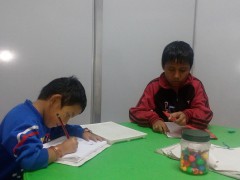Enabling Children with Special Needs at CHEERS

The little boy who is suffering from both blindness and autism seemed upset and was crying in the arms of the caretaker. He had just been admitted to the Enabling Centre of Children’s Hospital for Eye, ENT and Rehabilitation Services(CHEERS) in Bhaktapur, Nepal, that day for rehabilitation services which would subsequently and, hopefully enable him to enter school one day. Coming from a very poor family from Dailekh district in mid-western Nepal, his parents are unable to take care of him. Having heard of the children with incurable vision and/or hearing impairment or both who had undergone life changing experiences at CHEERS, I stepped down into the basement which houses the spacious Rehabilitation Unit, appropriately known as the Enabling Centre to find out more.
Only a few children were present that day in the Pre Braille Practice Room as most of them had not returned after the Deepawali holidays. The staff informed me that they provide unconventional proactive services to children with disability (blindness, hearing and speech defect, cerebral palsy and autism) in a gender, child and environment friendly setting. This innovative facility also gives free boarding, meals, tuition and clothes to children thanks to the donations of kind-hearted souls. It is not just the children but family members, caretakers, school headmasters and resource teachers are also given training on how to take care of the children with disability at home or in schools in a continuum of care. So far 54 children with visual or hearing disability, between the ages of 3 and 6 have been enrolled at the Enabling Centre. After being trained at the Enabling Center which varies from 3 to 9 months in some cases, 31 of them are now enrolled in in Early Childhood Development Centers (ECDC) for the first time in this Himalayan nation. Seventeen children with various types of disability are currently undergoing training at the Enabling Center. In the last decade and a half, Nepal’s Ministry of Education(MoE) has set up 34,000 ECDCs, for children between 3-5 years of age with a view to increase enrollment and retention of children in primary schools which has been very successful but with a caveat that none of them had a child with disability enrolled until this innovative step of pre-ECDC was taken by BPEF-CHEERS in 2013.
This initiative has been successful in removing at least one of the many forms of marginalization in Nepal. As a consequence, CHEERS is now being used by the Ministry of Education (MoE) as a Learning Resource for Government teachers. Several batches of teachers and ECDC staff have benefited from their learning experience at the Enabling Center In addition to children, the Enabling Center also caters to the needs of adults and elderly persons with sensory disability to get them to lead independent and productive lives to the extent possible.

A Child with blindness Practicing Braille in Pre Braille Practicing room. Photo by Author(CC-BY-NC-SA 3.0)
Further fulfilling BP Eye Foundation, the parent foundation’s pledge to gender and generational equity the hospital gives preference to the girl child in education, and women and persons with disability in employment. A breast feeding room for lactating mothers is another measure of the organization’s gender-friendliness. Girls and women constitute 60% of service users at CHEERS. Gender sensitivity is evident not only among service users but also in the B.P. Eye Foundation’s governance with over a third of women board members and close to half women among hospital staff. Ramps for people with disability, blind-friendly walking pathways with embossed tiles, voice activated elevators, braille switches, disabled friendly toilets are the hospital’s ways of making the hospital disabled friendly. Brightly painted walls, cartoons on the walls in waiting halls and examination room and both outdoor and indoor playing areas for children amply demonstrate the meticulousness of the planners to be child-friendly in addition to a week –long training of staff on child rights prior to starting of the hospital services. BP Eye Foundation’s Children Hospital for Eye ENT and Rehabilitation Services (CHEERS) is truly an inclusive development initiative.
In the year 2014 alone CHEERS reached out to over 33,000 patients through its various outreach programs including among others, another of its own innovation. Dedicated Children’s Eye, ENT Camps are organized in cooperation with Ministry of Health and Population (MoHP),Ministry of Education (MoE) and Ministry of Federal Affairs and Local Development (MoFALD). The outreach programs of BPEF-CHEERS liberally engage Female Community Health Volunteers (FCHV) who have become global health celebrities by reducing maternal and child mortality in Nepal to meet the targets of Millennium Development Goals.
Innovation being its niche, this initiative of CHEERS has helped children with disability foster a mutually helping attitude where one child’s disability is compensated by abilities of another child, albeit with a different disability. Here children are usually trained in speech therapy, daily living skills, and behavioral, motor and sensory skills together with other such children on a needs basis. This prepares them well for further education in pre- primary or primary schools. CHEERS plans to bring in non-disabled children in the soon to be expanded nursery, to promote inclusive education.
Nelson Mandela’s remarks, “Disabled children are equally entitled to an exciting and brilliant future.” is well resonated in this unique facility. I hope to meet the little boy again, (and many others like him and more of hers) and see his progress on my next visit. I am confident that he has an exciting and bright future in store for him too like other children.
Tags: autism, blindness, children with disabilities, deafness, education, gender equity, generational equity, marginalization, people with disabilities, rehabilitation

